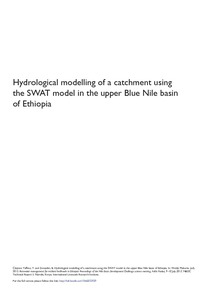Resource information
Sustaining upland agriculture and food security is very much constrained by continuing land degradation brought by soil erosion due to lack of effective rainwater management strategies. Recently a large body of research evidence has established that significant potential exists to increase agricultural productivity through sustainable rainwater management interventions. Hydrological models are essential to understand the hydrological response of a catchment. The current paper focuses on hydrological modelling of catchment with SWAT model using its two versions, SWAT-CN and SWAT-WB. It is also aimed to verify the impact of existing land and water management practices on runoff yield and the applicability of the model for water resource assessment in the watershed. The model was applied on two watersheds, Mizewa (27 km2) and Gumara (1278 km2) that are located in the upper Blue Nile basin of Ethiopia in Fogera district. Data needed for modelling work was collected from available nearby stations and from the recently installed hydrological-meteorological stations. Model performances were compared prior to parameter optimization . After these initial findings, the SWAT-CN model was calibrated and validated and hence reasonable results were obtained. The results indicate that the model performance was in acceptable range and there are no many changes to predict the flow by the two versions of SWAT model. The concept of rainwater management is at an infant stage, though water scarcity and catchment degradation are serious threats in Mizewa watershed. HRU analysis indicates that agricultural land is the most runoff generating areas. Soil evaporation compensation factor (ESCO) and initial SCS curve number II value (CN2) are the two most sensitive parameters indicating that effective rainwater management interventions has a great impact in reducing soil erosion and land degradation. Some future management interventions were proposed such as discussing with local farmers and stakeholders.



